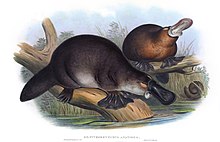John Gould
John Gould FRS (/ɡuːld/; 14 September 1804 – 3 February 1881[1]) was an English ornithologist who published monographs on birds, illustrated by plates produced by his wife, Elizabeth Gould, and several other artists, including Edward Lear, Henry Constantine Richter, Joseph Wolf and William Matthew Hart.
After working on Dowager Lady Poulett's glass house, his father obtained a position on an estate near Guildford, Surrey.
a number, subscribed for in advance, and in spite of the heavy expense of preparing the plates, Gould succeeded in making his ventures pay, realising a fortune.
[3][8] This was a busy period for Gould who also published Icones Avium in two parts containing 18 leaves of bird studies on 54 cm plates as a supplement to his previous works.
From them he was able to establish that the species were unique to islands, an important step on the inception of his theory of evolution by natural selection.
[11][12][13] In 1838 the Goulds sailed to Australia, intending to study the birds of that country and be the first to produce a major work on the subject.
They arrived in Tasmania in September, making the acquaintance of the governor Sir John Franklin and his wife.
He travelled to his brother-in-law's station at Yarrundi,[14] spending his time searching for bowerbirds in the Liverpool Range.
In May he sailed to Adelaide to meet Charles Sturt, who was preparing to lead an expedition to the Murray River.
Gould collected in the Mount Lofty range, the Murray Scrubs and Kangaroo Island, returning again to Hobart in July.
[16][17] Elizabeth died in 1841 after the birth of their eighth child, Sarah, and Gould's books subsequently used illustrations by a number of artists, including Henry Constantine Richter, William Matthew Hart and Joseph Wolf.
Even after leaving Australia, John Gould corresponded with many scientists and collectors in the colonies, including Frederick McCoy, who was the director of the National Museum of Victoria from 1857 to 1899.
Gould insisted that any species of birds that were at that time new to Western science be forwarded to him in London to be described and figured.
Sotheran's[21] reports that Gould published the book himself, producing 750 copies, which remain sought after both as complete volumes, and as individual plates, currently varying in price from £450 – £850.
Gould then oversaw the process whereby his artists worked his sketches up into the finished drawings, which were made into coloured lithographs by engraver William Hart.
There were problems: the stone engraving of the snowy owl in volume I was dropped and broken at an early stage in the printing.
[23] The Tasmanian giant freshwater crayfish (Astacopsis gouldi) was named after Gould's son Charles.
[25] A visit to Gould in his old age provided the inspiration for John Everett Millais's painting The Ruling Passion.
Elizabeth Gould died from puerperal fever after giving birth to Sarah, her eighth child.
The pioneering epidemiologist John Snow mentions Gould and his assistant Prince in his famous publication: On the mode of communication of cholera.





